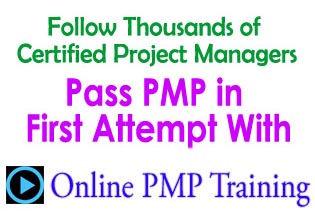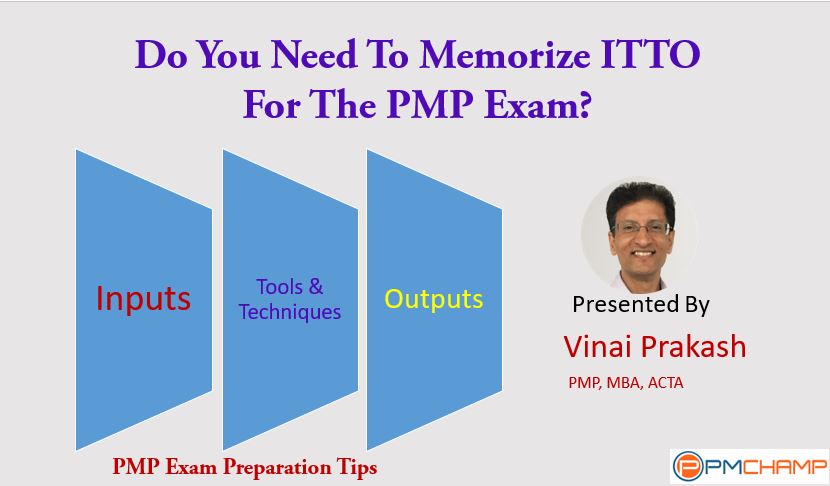ITTO stand for Inputs, Tools & Techniques & Outputs.
ITTO’s exist for each of the 47 Processes, based on the PMBOK Guide, Sixth Edition. These processes are spread in the [intlink id=”38″ type=”post”]10 Knowledge Areas[/intlink] and the [intlink id=”40″ type=”post”]5 Process Groups[/intlink].
Understanding the ITTOs is vital to pass the PMP Exam. Atleast 40% of the PMP Exam questions (roughly 80 out of 200), can be answered correctly if you have a solid understanding of the Inputs, Tools & Techniques, and Outputs of the Processes… and their interactions.
However many people just resort to memorize them, and guess what… memorizing it for 47 processes not easy, and is not really necessary. Yes, you need to remember them for a few processes to be exact, but not all. If you attend any PMP Training, or buy a good Exam Prep Book, you can understand how the different processes interact with each other. The output of any process becomes the input to the next process in the logical order.
Even if you are able to memorize it, you may make mistakes, or may not be able to answer the PMP exam questions if you do not understand the relationship between the different processes.
Test your knowledge of ITTOs for PMP Exam?
Answers to these 3 questions are provide at the bottom of this post.
Importance of Knowing the Inputs, Outputs, Tools & Techniques for Each Process
How to Remember ITTOs for the PMP Exam
- What is the correct sequence of processes?
- Which process comes first? Which process would have been completed before this process can start
Practice Tips
Answers to ITTO questions above:
Q1: Correct answer is B – second choice
Q2: Correct answer is C – third choice
Q3: Correct answer is D – fourth choice
A Handy ITTO Resource Guide for you to print and carry around
We have created a handy ITTO resource guide, that you can print and carry around with you, to read as and when you get time.
You can get it here (Excel 2003 File – Right Click to Download) – ITTO-for-PMP-Exam
Attend Online PMP Training by PMChamp Coach Vinai. Watch a video each day, and learn important concepts in easy, bite sized pieces.
Hope this helps you in preparing for the PMP Exam in a better way. All the Best!
Cheers,
Vinai Prakash, PMP


The link for excel file is wrong. I couldn’t download it.
Here’s the direct link to the excel file http://www.pmchamp.com/wp-content/uploads/2010/10/ITTO-for-PMP-Exam.xls
No doubt, ITTO is very important from Exam point of view. I have used “PMP Resource” on my iphone/ipad for reviewing and understanding ITTO.
Once you select a choice and vote… it no longer shows it in order… it shows the answers in order of votes… so I have no clue if I am right or wrong anymore… you should put in your answers the actual answer… Just a suggestion… OR rewrite the questions out without the vote..
I am regretting for paying a very expensive BOOTCAMP which cannot even compare to your PMChamp videos. They are clear and straight to the point. I wont schedule for my PMP exam before I take your 6 weeks course.
Understanding the context of the ITTO’s is important. You need to understand the ones which are relevant but more the context of the inputs and outputs and the relations to the processes. e.g. which process is first and gives as output input to what other process. This is not obvious without understanding the whole picture and you would fail in the exam by purely memorizing without understanding. Plus only a genious would be able to fully memorize without understanding the logic behind. Practicing that context every day together with doing all the mock exam questions you can retrieve from reliable sources will help to improve the chance to pass
Able to download the Excel through the link.
answer of 1st question is D not B, for more info refere PMBOK5 Page no. 354,
11.6.3.4 Project Documents Updates
Project documents that may be updated as a result of the Control Risk process include, but are not limited to the
risk register. Risk register updates may include:
• Outcomes of risk reassessments, risk audits, and periodic risk reviews. These outcomes may
include identification of new risks, updates to probability, impact, priority, response plans, ownership, and
other elements of the risk register. Outcomes can also include closing risks that are no longer applicable
and releasing their associated reserves.
Irfan,
You are contradicting yourself. Perhaps you missed the EXCEPT at the end of the question 1. This is a negative question. Option D is what you would expect to be updated as an update to the Risk Register. Try again…